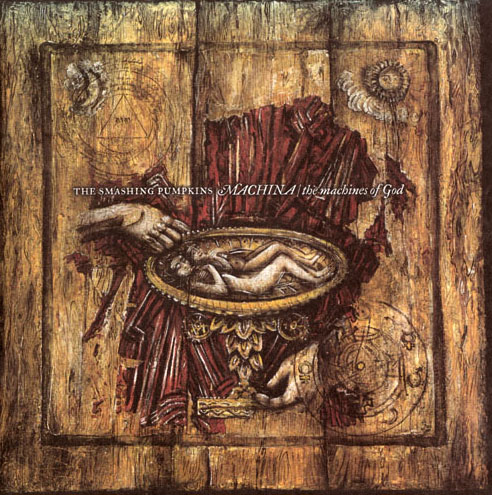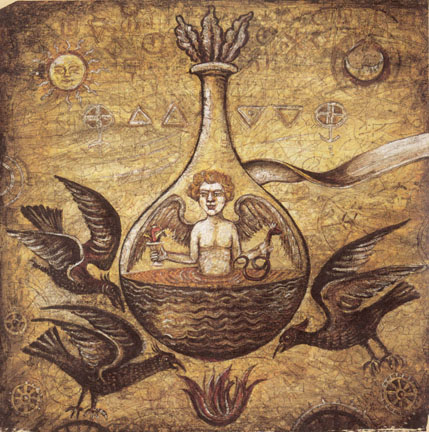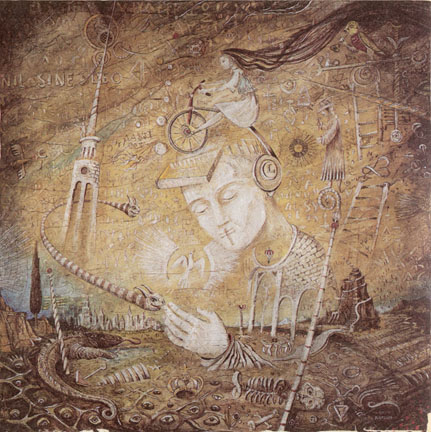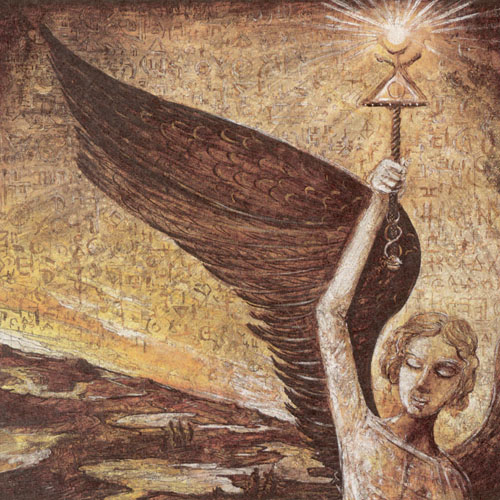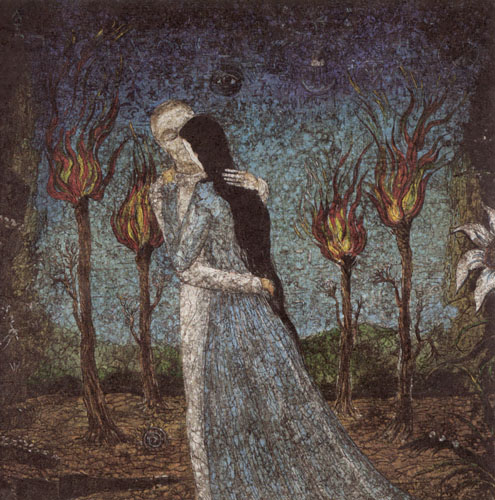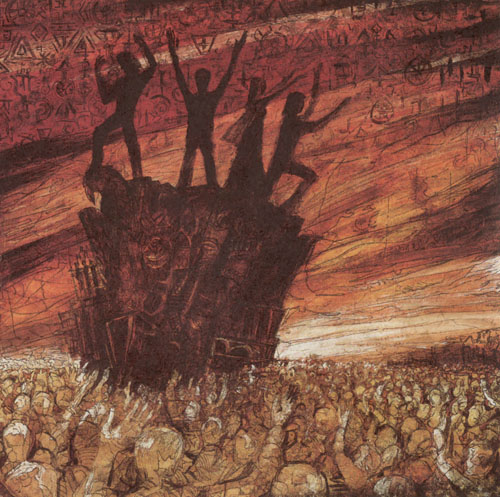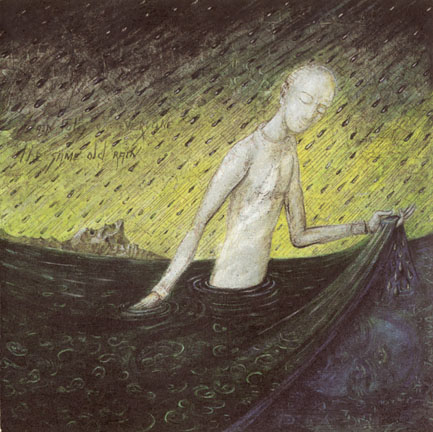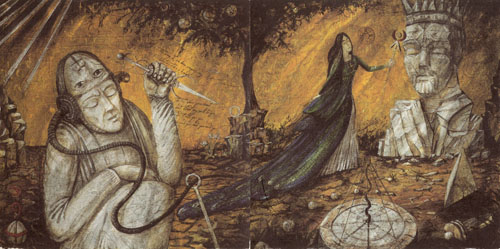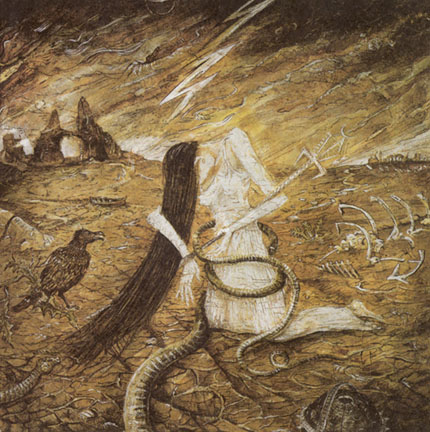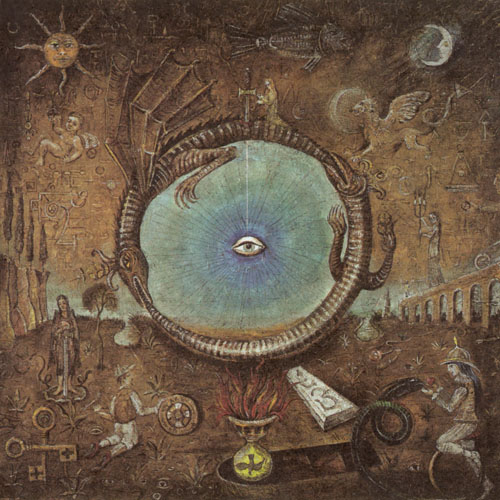The in depth study produced by Brad Jaeger serves to provide full depth to the symbols (see Plates I-V here, Plates VI-X here, and Plates XI-XVI here); the mesh between the symbolism of alchemy and the Christian occult (is there such a thing) and the existing reality only deepens in accord the further you go. This must strike a balance between what she first perceived and all she would remain blithely unaware of, a point of deliberate intractability, it would turn out. This distinction should be obvious for Plate II, from which all she could garner was the title, “The Soul as Living Proof”. This after she’d delivered The Sanctification Principle to him personally, which was her attempt to demonstrate how her own soul had become this exercise. –Oh, yes. She’d also provided her little explanation as per Trent and The Fragile, -which was precisely the aspect where this had become realized as an existing dynamic; that was her assertion, at least. In effect the title was all she needed to know; she’d already “told” Billy about it. (On this one Brad is incorrect. The title was not a pun.) The take on the alchemical process was purely literal (going through a process of putrefaction and reduction to blackness); in her context, “The Soul As Living Proof” was the result. It is true that the third plate, “The Chemist Brings Spark” is related to “Glass & the Ghost Children” (which bore more than a little relation to Live’s “The Face & Ghost”, though that was far more positive). It was literally true in the sense that the state of the connected awareness had initially been drug induced, by the most potently concentrated psychoactive perhaps still known to man, LSD, which in her circumstance had indeed provided the microcosmic moment where she’d deliberately entered “Nigredo”, the process of blackness and reduction into the primal matter from whence it came, to facilitate transformation into new life, signified as “Albedo”, the white state, which is still a state of purification. Again the title was all she really needed to know; thankfully Brad goes far further than that.
The same was true of Plate IV “Let the Truth Sing Divine”, (because that was what was happening), which in Brad’s reference brings out a coincidence that would not become apparent for years, that the word “Sylph” (the word she’d used exclusively for her protagonist Aoreth in her interior myth which she was beginning to decide was a projection); this word had been conceived by Paracelsus, who was considered a father of alchemy; Billy would deliberately use his name in his further development of the “Mystery”. (The first time she ever yielded to calling Aoreth a “faerie” was Machina Mystery 5, for the sake of popular consumption.)
Plate V was truly startling for her, particularly in terms of the title, “Desire Holds the Moment Still”. This was because she’d drawn her lovers, two that existed in her story, (she’d actually combined both sets of protagonists in the drawing) in the same pose, and here the figure connoted to be “Glass” replaced him, holding June. In her own depiction her hair had been just as long, and the full length dress quite similar. There was a subtle distinction; in her drawing the two had come apart in their embrace, and he was gazing at her with the first inkling of distrust. (The depiction weighed more on the side of Thiaerin’s parents, a union that collapsed in betrayal.)
Plate VI, “As the Machines Resume” again found its main connotation (for her) in the title, because the machines were resuming, and the feedback loop, as she saw it, had come back on all cylinders after her interior mental resurrection. There is no divergence in interpretation that the “Machines” represent the band themselves, and curiously in terms of her and her father’s argument over whether they were simply “speaker equipment” that amplified the Divine truth (the position she’d never agreed with), his position would have provided a first step in a form of demagoguery, because the following in that circumstance is literally headless and without reason, without ever possibly knowing it. It wasn’t the only time where Billy would point out a dark undertone of simply being a performing device in an overall much bigger, Orchestrated picture; that was the context entire of “Heavy Metal Machine”, and was referenced in “I of the Mourning” as well.
Plate VII was the most striking for her and deliberately tied into the Machina track “Raindrops & Sunshowers”, by excerpting its lyric in the clouds which provided the rain and formed the backdrop. It was only further reinforced by the unhappiness in the song itself, which was brought on by dealing with a connection that was nebulous, only existent in an interior sense that was fleeting and subject to realms of doubt. For her of course, in terms of the analogy she’d possessed since what she thought of as the connected awareness’s very inception, that of the universal unconscious sea, this sadness was explicitly attached with this illustration to the existing circumstance, i.e., he only sensed her through the universal unconscious sea, which created interference in terms of whether what he sensed was even her love, or just his own. This was not a true reflection, in the sense that it was once removed and negated her humanity, but depicted their only existing connection, the only way he “saw” her at all. The woman under the water Glass peels back to view possesses a third eye, as in “Cash Car Star” - “my baby’s got three eyes, my baby’s got three eyes, she holds her hands behind her back, she’s got a big surprise”. That song declares “everyone is going to be a big star” and “everybody’s business is everybody’s business” because her big surprise was in fact an existing universality, which implies everyone’s existence collectively on a pre-defined spiritual level that makes them stars.
By virtue of this depiction she was also the subject in “Raindrops & Sunshowers”, the object of his “secret love”. In the song it is also acknowledged that the song itself he sends back to her is an echo, i.e., reciprocity inside the feedback loop, his attempt to walk with her despite the overwhelming sadness of the circumstance, which obviously in its way was heartening to hear the moment one felt the existing situation had just managed to stab one’s heart straight through like being split in two; the tears were endless. She’d just given him a lecture (titled The Sanctification Principle) that declared this depiction to be the structural circumstance, as well as conveying she was not happy about it. And wasn’t it a lovely circumstance to be in, about as good as “prospecting between Scylla and Charybdis as my forms of counter-insurance. Fare [between] the Devil's advocate, or becoming permanently lost in the deep blue sea.”
Plates VIII & IX (the “diptych” plates) – Here we have some serious digression on what this illustration implies. For Rahab it was confirmation of 1) his existing relationship, while 2) at the same time depicting Glass’s mind connection with another feminine figure, which took place through his headphones. Most crucially, the lyrics depicted around the dagger he held in his hand quite simplistically demonstrated his intent, which were lifted from “The Crying Tree of Mercury”. These were the lyrics that explicitly captured the sense of the existing universality:
"[This is] the song I've been singing my whole life
I've been waiting like a knife
To cut open your heat
And bleed my soul to you
I did it all for you
You and you and you and you"
For her this conveyed that the dagger was intended for her with whom he had an existing connection in his mind, as it was conveyed as being the content of the transmission between them, combined with being the intended action of the object in his hand, which for her, before even hearing it, was the sum, pretty much, of just initial exposure. It was no surprise at all to have both a tree and the statue of a king depicted in the plate, given her confrontation with a self-ascribed one and that the event of the “everlasting tree” had been something that confirmed where she really stood, and helped reinforce her decision to leave, partly through the process of reinforcing her own self-realization. The Plate’s title was “So Empowered, the lovers negate the blinding brilliance of love”. To her it was ready indication that the lovers were in fact the pair existing in a mind connection. From this vantage then she could otherwise consider that June was shown both ways, also being the woman depicted with the scepter (in a dress that deliberately conjures the sense of water waves combined with fish scales) before the “desecrated bust” of the king, who Brad asserted to be King Solomon without sourcing it. It is true he was a king who being most blessed by God, eventually fell from grace. There is also a depiction of the “philosopher’s compass”. That the image depicts Glass’s androgyny in depicting him in the form of Janus, being pregnant besides (Brad’s interpretation) is non-existent; the figure is sitting on the ground in a white robe; those are his knees. His full concentration is on the mind connection, not externalities, i.e., isolating the import so he can articulate the return message. Additionally the woman with the cross sealing her lips was depicted as her own entity elsewhere, as anyone owning the CD knows, she was drawn on the CD itself. She is not simply Glass in the form of Janus, but exists in her own separate depiction. There is a cross sealing the woman’s lips, which was also depicted on the stand alone female figure on the disk. She is impelled to silence, forced to keep secret a sacrifice, and Glass in his concentration gives her voice. (For just how literal this happens to get in terms of how she been personally sacrificed (literally), read on; or just hop to 8:41; reality knocks you over the head with a mallet.) Curiously their mutuality in love that is blindingly brilliant is titled as being negating. But in a sense it was no surprise, as for her at this moment, to exist in separation at the moment was wholly devastating, and so it was utterly negating on an emotional level, to learn of it, precisely in the same moment that empowered it. Her hope was nigh infinite; so was the pain.
Plate X was a depiction of June’s valley of darkness, titled, “The Heavens Cry Her Mortal Thirst”, and without even the depth Brad ascribes to it, is apparently attempting to slit her own wrist, i.e., attempt [“ceremonial”] suicide [“in an act of self-sacrifice”]. It was with this Plate Brad’s interpretation truly enriched what was depicted, describing the full depiction of Nigredo, the first stage of transcendence and inferring “seppuku” – “an especially painful form of suicide”, which could not have been more accurate in terms of what took place on Thanksgiving 1995. In Brad’s words:
“Seppuku was an act traditionally carried out to restore honour; deny the enemy the privilege of capture, or to make amends for one's actions. It was typically carried out by driving a ceremonial sword or dagger through the chest, and self-eviscerating and disemboweling oneself. While jigai, -a similar act done by the cutting of the jugular vein -was more commonly used by women than seppuku, it is not completely unheard of for a woman to commit it. Another reminiscent element of seppuku present in the plate is the fact that the women in question is dressed in white ceremonial robes, as was common with those who were about to commit the act.
Seppuku was an especially painful form of suicide in which the individual was expected to keep their composure, suffering through the act in silence. Some of the most devoted would compose a death poem, written in tanka style, as they waited for death to claim them.”
As per the title, the heavens had indeed cried, in the sense that her death and disappearance were universally expressed. And in terms of ceremonial seppuku, all three purposes for the ceremonial suicide (performed without anyone in the room even knowing it was happening), had been true.
For Plate XI the title, once more, was enough, “The I of the Radio”, as she knew it was the declaration of God as existing, “I AM” by the orchestration of the existing feedback loop, the substance of her God Proof she’d just delivered to both men. Here Brad elegantly summed in short the symbolism of mercury:
“Moving now to the fish, due top and center. The fish, like its role in Plate XIV (Turning Tears Into Oceans, Words Into Sand), once again is symbolic of mercury; the feminine and passive transformational liquid, under whose influence it is possible for great transformations to occur.”
And for the rest of what is contained in this depiction, you may well refer to him, concerning the ouroboros and “the all seeing eye” especially, which combined represent the title in artistic form and symbolism, -except for the radio part. Plate XII is best left to Brad’s elucidation, “In all Things the Symbols Reign Supreme”, representing “It is finished when the seven are One”. The title was simply literally true, because it was a conjunction of symbolism that had started what had happened to begin with, combined with their transmission; it was the use of these symbols in unintended cross reference that was the causality of any imputation of universality.
Plate XIII, “Torn Inside Machines of Light” was in no way a stretch at the moment, based on what she was going through, and witnessed in him in London. It was being caught in the wheels of Divine destiny, the same immutable wheels as “the machines of God”, the doom of Glass and June, “another cog in “the God Machine”” in terms of their existence inside the feedback loop that worked as a God Proof. Plate XIV was meaningless to her, and in fact there was sort of a curious relation where those plates deeply involved in alchemical symbolism did not have import where she was concerned, apart from what they could be said to represent.Plate XV “Bracing Against the Inevitable Doubt” was of course quite the opposite, as she was constantly assailed by doubt even as per whether she and Billy might be connected; once again for her an invocation of the title alone, though the depiction would signify this taking place inside someone’s mind. Plate XVI, “The Echo Rings Forever On”, conveyed Glass’s departure from the world, and signified the capture inside the “echo”, that is, the feedback, of transcendence, as the echo that would ring forever, which was exactly what she expected in terms of their mutual transmission, reciprocity and what it meant. Incidentally, unknown to her, the cover art for the single release of “Try, Try, Try” also happened to signify the only two prophets who were sent alive into paradise, Elijah and Enoch; Enoch hardly appears to qualify except in ascendency, for there was no allusion to his life as a prophet Biblically. The cover to the “Stand Inside Your Love” single (which obviously she possessed) obviously represented duality.
